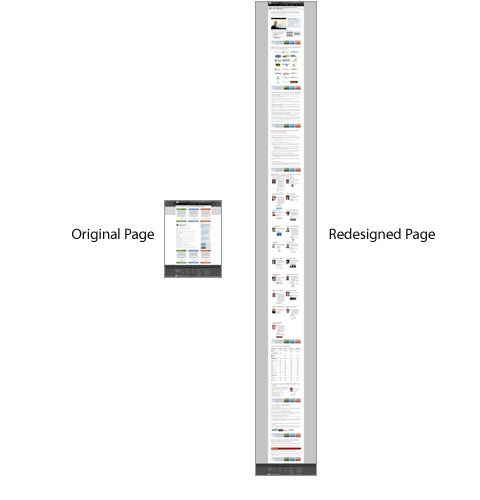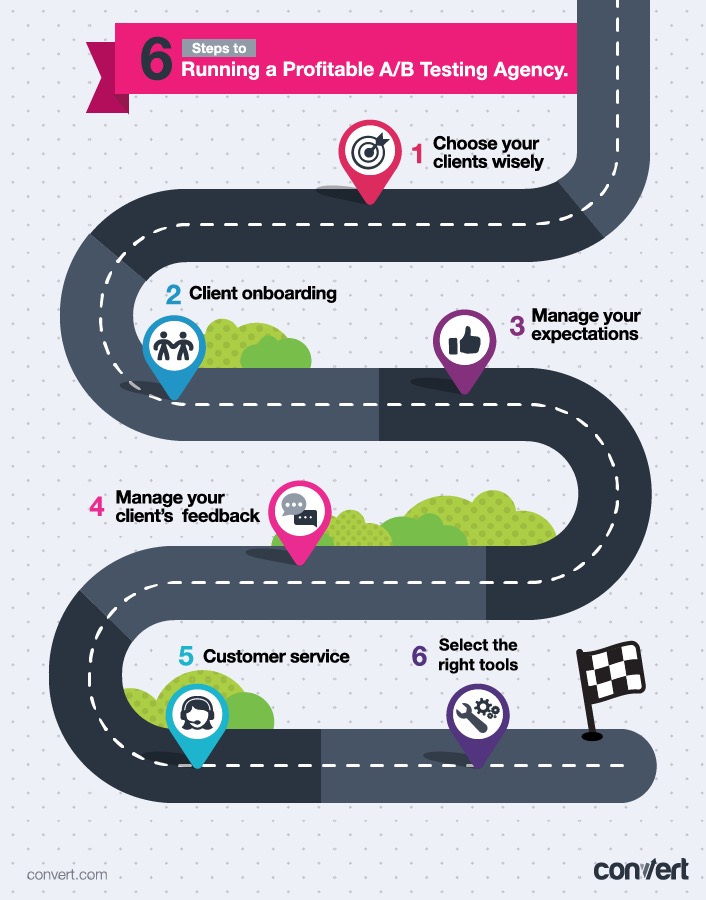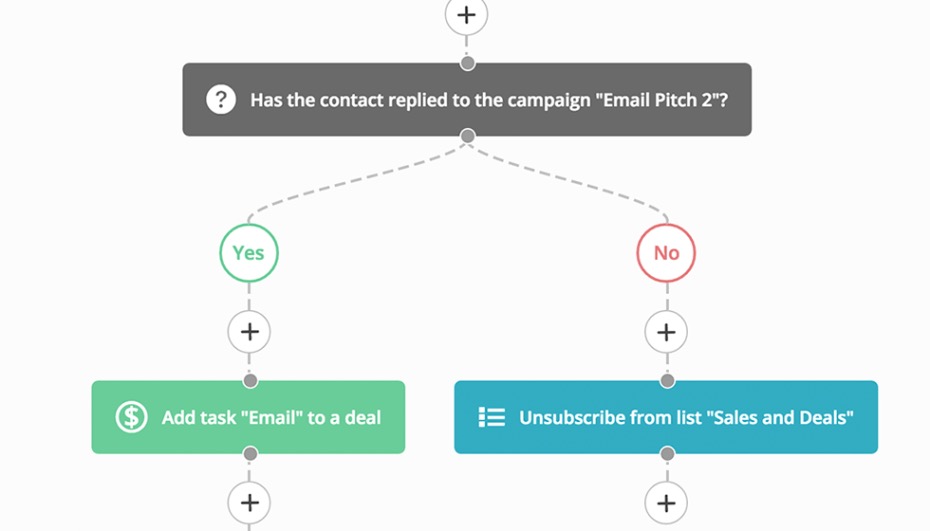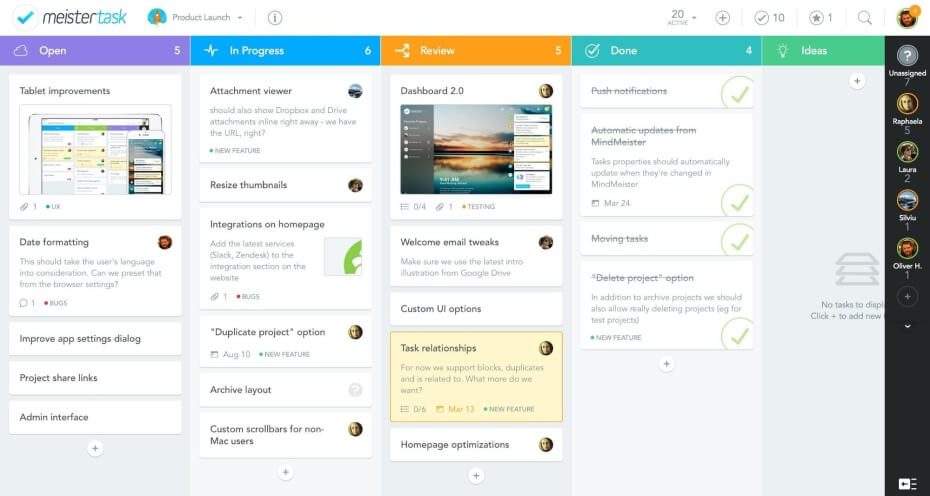6 Steps to Running a Profitable A/B Testing Agency
Moz’s CEO, Rand Fishkin already knew the value of optimization when it came to increasing traffic through the search engines. He dropped out of the University of Washington in Seattle in 2001 to start Moz, a then-burgeoning young SEO company which he grew to one of the world’s leading SEO authority sites. He knows the power of data-based marketing and optimization.

But even Rand was surprised at the 170% conversion rate increase CRO agency Conversion Rate Experts managed to achieve in only four months.
This case study has become legendary in the CRO industry, most notably due to the size of the landing page that Conversion Rate Experts created as part of their optimization process.

The new landing page helped generate more than $1 million in additional revenue for Moz.
So to help you achieve greater success with your agency, here’s 6 steps to help you run a profitable business.

1. Choose your clients wisely
One of the best skills you can learn in business is how to say ‘No’. It’s an undervalued (and underused) skill.
When you’re first starting out in business the pressure to say yes to every job offer that comes along is strong. Beggars can’t be choosers, right?

Actually, you can sink your company by working with the wrong clients.
It takes just one or two nightmare clients who demand 80% of your agencies time, while simultaneously paying you the lowest fees (often late) and grumbling about your prices all the way along.
These clients suck your team’s time and lower moral.
Compare them to the best client you’ve had—the one who was happy to pay top dollar for your services and always paid on time.
Imagine having a portfolio of clients just like them …
Well, stop imagining this and set up the processes to make it happen. First, here’s are the red flags to watch out for when talking to a prospective client:
- Do they communicate well? Do they reply promptly to your emails?
- Do they quibble about your prices? Do they ask for discounts?
- Do they read the information you provide them?
- Do they give you the information you ask for?
- Do they have realistic expectations of the project’s outcome?
Points a and b are the most important to be aware of—if a client fails either of these two questions you need to run a mile.
Once you’ve decided a potential client is not up to mark you can turn them away and to do that you’ll need to have:
- A credible reason,
- Be sympathetic, and
- Not leave any room for negotiations.
Here’s a script for saying no to a prospective client who raised a red flag:
Dear Client,
Thank you for getting in touch with us.
Unfortunately, it looks like we won’t be able to accommodate you. Your project falls outside the scope of our expertise/ We’re not taking on new clients at the moment/ we’re booked solid for the next 6 months/ etc.
Best of luck for your project. Sorry we couldn’t be of more help.
Irrespective of your decisions to say no to a client, being respectful is key—they may know someone who does fit your ideal client persona.
Saying no to clients who aren’t the right fit will be the best thing you’ll ever do for your business.
2. Client on-boarding (and automation)

Increasing profits isn’t always about increasing rates and taking on more work.
By improving internal systems and processes you can streamline and automate parts of your business, and in doing so reduce costs.
Reduce costs = more profit.
Systems and processes allow you to create consistent experiences for your team and your clients—and when you have consistency, you’re able to track and measure profitability.
You can create processes for any repetitive task or action in your business. The key is getting your systems out of your head and onto paper. Without proper documentation, you rely on memory to get things done, which is how things begin to fall through the cracks—especially when you start to get busy.
Systematizing and automating processes also has the benefit of saving time—allowing your agency to take on more work.
As an example of this, let’s take a look at your client on-boarding process. A typical on-boarding process looks like this:
- The client reaches out to you with a problem.
- You reply and try to set up a call.
- You email back and forth a number of times to finalize a date and time for the call.
- The client ends up not been able to make the call and so you have to reschedule.
- You finally get a call together to discuss their problem and your agency’s solution.
- After the call, you email them a few other questions you forgot to ask on the call.
- You then send the client your proposal and hope for the best.
Does any of that sound familiar?
Now, if we take the time to actually plan how we want this initial client interaction to unfold, we might put together a process like the following:
- The client reaches out to you with a problem by filling out a form on your website.
- They’re added to your email list and automatically sent a link to your “Getting Started” page which introduces your services and how you work with clients. It answers all the common questions you usually get asked on email or phone. It also includes client testimonials (keep reminding them why they want to hire you).
- At the end of the page, there’s a link to fill in a project planner.
- A project planner is a form (try typeform.com which is free). It stores their answers and emails you when they finish.
- Once they fill in the form, the final screen includes a link to schedule a call.
- The call booking form only shows free time on specific days (I use setmore.com). Once they pick a time that’s available for both of you, you’re each sent an email with the call confirmation and reminder.
- Before the call, you send them the meeting agenda which provides a clear outline of what you’ll be discussing on the call. This keeps the call on track and makes sure you don’t miss anything.
So, by the time you actually talk to them for the first time—you’ve already set their expectations, they’ve answered your preliminary questions and they’ve scheduled a call with you—without you having to lift a hand …
From the client’s point of view, they’ve had quick responses from you, had their unasked questions answered in the “Getting Started” page, and have promptly scheduled a meeting with you.
You’re already looking smart and professional in their eyes. Job done!
Download a more detailed onboarding process in our free PDF.
3. Managing expectations

You’d have noticed in our improved on-boarding process that we directed potential clients (that had contacted us) to a “Getting Started” page.
This “Getting Started” page is all about setting the right expectations for the client. Managing expectations is the single most important aspect to maintaining a healthy and profitable relationship with your clients.
As you know, you don’t increase conversion rates for every A/B test that you perform. Sometimes your plans and big ideas just plain flop. It happens to the best of us.
This is where it’s important you educate your client on the different possible outcomes and how you’ll handle it when there’s a negative result.
Here’s a list of 7 expectations I set for my clients:
- What’s included in my service: yes I know that sounds obvious, but most people don’t know what running A/B tests actually entails. The amount of work required often surprises clients and helps justify the value of your fees.
- What’s NOT included in my service: which is just as valuable as my point above. Make sure it’s clear what you don’t provide.
- The guarantee: what exactly are you guaranteeing and what are the client’s requirements to validate the guarantee, for example, you require over X number of traffic per month and minimum 6-month project duration. If you don’t offer a guarantee, you may want to explain your reasons why.
- The process: where you outline each step of the project. Clients get worried when they don’t know what’s happening, so understanding your process can help alleviate that fear.
- Single point of contact: the client should have a single point of contact within your agency, and you should have a single point of contact with the client for approvals and sign-off’s. This helps prevent miscommunication.
- Communication: how will be handled? Email, phone, Trello (I love Trello for project management)? What’s a reasonable response time? If you don’t set this up front, they might expect a response to an email within an hour, when your standard response time is within 1 business day.
- Payment terms: I understand it can be uncomfortable talking about money, but it is a necessary evil. You’ve got to discuss and agree to the payment terms up front. Are the terms net 30, net 15, or immediately upon receipt? What happens if the client doesn’t pay on time? Will you charge late fees or interest?
By explaining your process and deliverables, and educating the client of your requirements of them, you both start the relationship with clear expectations of the other.
4. Managing client feedback

Some clients will have an opinion about everything and will want to be highly involved with the work you’re doing.
This is fine (to a point), but they’ll need to be carefully managed and expectations set clearly regarding each party’s roles within the project.
A big part of this is your client’s feedback. It’s important they have their voices heard, and that you hear (and more importantly comprehend) the message they’re trying to convey.
Good communication includes knowing when to say no. The team should never promise anything they know they can’t deliver. Saying no in the beginning could save an overabundance of unnecessary problems later.
But remember, no one is born with the ability to give great feedback, it’s a skill that’s learned just like everything else. So you have to educate your client on how to give you feedback.
Here’s some general do’s and don’t’s you can highlight to your client.
Please do…
- DO feel free to tell us what you don’t like. If you don’t tell us what you think isn’t working, we’ll provide you the same thing again and again.
- DO go into as much detail as possible as to why you feel something is not working. Your reasoning is critical to solving the problem.
- DO speak about your goals and priorities for the project.
- DO tell us why we’re wrong about certain decisions we’ve made. Part of the process is finding those holes.
- DO limit the number of people in the review cycle to allow faster, more succinct feedback.
Please don’t…
- DON’T prescribe solutions because they need to be reverse engineered to get to the real issue.
- DON’T mock up new designs or alterations to our designs. Doing so is counter-productive because we then must reverse engineer the whole thing to find out what you were trying to solve. This results in lost time, and budget.
- DON’T forget you hired conversion rate optimization experts and your job is to be the business, expert.
5. Customer service

Hopefully, you’ve made a good first impression with your client as this positive start goes a long way and enables the client to gloss over any minor bumps in the road.
But with most projects, and relationships, there will often be at least one major bump in the road.
How you handle this incident is the difference between a good agency and a great one.
I’ve found from past (and painful) experience that you should do 2 things when something goes wrong:
Be honest
Tell them straight and take ownership if the blame falls on your shoulders. Don’t put yourself down, but explain what happened and why.
Then more importantly, explain what you have done/will do to fix the problem and what steps you’ve taken so that the problem won’t occur again.
Bonus: your lies won’t come back to bite you on the bum—which they invariably do.
If the mistake is at your client’s end, again politely explain the problem and provide a possible solution to reduce the chance of it happening again.
Keep the communication channels open
It’s easy to say to yourself “if we stay quiet and quickly move on, maybe they won’t notice or will forget”.
But most of the time they will notice and this will make you look bad in the fact that you failed to notice the problem, or that you did know about the problem but tried to cover it up. Either way—you lose.
Or there’s the “we’ll get the problem fixed first so when I talk to he client I’ll have something positive to say”, but, of course, it always takes longer than you think to fix.
Meanwhile, the client, who has noticed the problem thinks you’re incompetent because you haven’t noticed the problem, or have but are not doing anything about it.
You haven’t spoken up remember, and the client doesn’t have special telegraphic mind reading abilities.
As soon as something goes wrong, speak to the client. Let them know you’re aware of the problem, that you’re working on a solution and you’ll update them as soon as you can.
I haven’t had a single client yell at me yet for being honest and upfront. Clients are people too and know that things can (and will) go wrong. They just don’t want to keep in the dark.
6. Selecting the right tools

Ah, the fun part! Who doesn’t like playing with new tools?
I have a bit of an obsession with online tools and are constantly trying out a new landing page builder or analytics suite.
Coming from a usability background I place a high importance on a tool’s ease of use. This is especially important in a team environment where different people with different skill levels must be taken into account.
So, here is a list of the tools we use at NerveCentral as well as popular alternatives.
i. A/B testing
You know the answer this one don’t you … we tried VWO and Optimizely, which are good alternatives, but we ultimately settled on Convert.
Convert has unlimited users/collaborators, unlimited projects and unlimited tests on all their plans.
‘Revenue’, the most important metric you should be measuring in your tests can be connected automatically which is a big time, save.
Ease of use and customer support has been excellent with my experience so far—and the icing on the cake: they’re currently 50%-75% cheaper compared to Optimizely (yes I know Optimizely has a free plan, but it’s limited) and 20%-30% cheaper than VWO.
ii. Analytics
Google Analytics, of course, but for those don’t drink the Google Kool-Aid a good alternative is Clicky.
If you’re looking for advanced funnels and cohorts, try Heap, Mixpanel or KISSmetrics.
iii. Visitor recordings & heatmaps
Hotjar is the hot choice in this category. It has a beautiful interface and a whole range of features like visitor recording, heatmaps, funnels, polls, and surveys.
A more pricey alternative is ClickTale.
iv. Landing page builders
I personally like Instapage for it’s ease of use, but Unbounce is also a popular choice. Also check out Wishpond as they recently updated their interface and feature set and with what I’ve seen so far it’s looking good.
ClickFunnels and LeadPages are also popular with the Internet marketers crowd.
v. Email marketing (and marketing automation)
My recommended choice and the service we personally use is ActiveCampaign. And the reason is, apart from the attractive interface, is the marketing automation features ActiveCampaign offers.

For a very reasonable price, you’re getting 90% of the functionality that far more expensive services like InfusionSoft and Ontraport provide.
Two good alternatives to ActiveCampaign are Drip and ConvertKit.
vi. Project management
Trello is my favorite here with its kanban style board which allows you a great overview of all your tasks in a project. I’m also trying out MeisterTask which is very similar to Trello in how it works. Both have free plans.

ClickUp, Asana and Basecamp are great alternatives.
vii. Customer support
While we tried a few help-desk solutions, we’re a small agency and are happy sharing a dedicated email address for support issues.
But if you’ve tried some of the big names in this field and want to try something different, check out Reamaze. It was the one we liked the best after trying Front and Groove.
viii. Payments
To accept payments from your clients you’ll need an online merchant account and for that we recommend Stripe.
To make things really easy for you, start using Snappy Checkout in conjunction with Stripe. Snappy Checkout provides you with a copy and paste checkout form for one off as well as recurring payments. Oh, they also integrate with PayPal which covers all bases.
If you’re based in Europe, check out Paymill and GoCardless.
So we’ve come to the end. Hopefully, you’ve learned one useful tip from this article which will steer you down the right path for success with your agency.
I’d love to hear what steps you’ve had success with in running an agency …
Oh … and don’t forget to Download the onboarding process in our free PDF.
Written By
David Crowther

